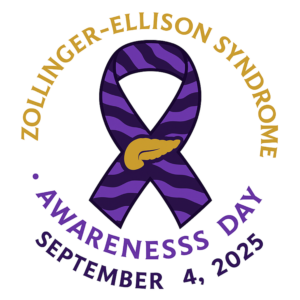Remember the Rare: Zollinger-Ellison Syndrome Awareness Day 2025
For the founding year of Zollinger-Ellison Syndrome Awareness Day, ChiRhoClin focused on the history of Drs. Zollinger and Ellison and their contributions to the Gastric Neuroendocrine community. This year, we’re focusing on the importance of testing for Zollinger-Ellison Syndrome, also known as ZES.

As a brief refresher, Zollinger-Ellison Syndrome describes Type II gastric neuroendocrine tumors (Type 2 G-NETs) and is often associated with multiple endocrine neoplasia (MEN-1).1 Type II accounts for the rarest type of G-NETs, with only about 5%-7% of all G-NETs in this category.1 When ZES is identified or MEN-1 is suspected, it is crucial to conduct serum sequencing.1 The MEN-1 gene normally contains a tumor suppressing protein called menin, thus conditions related to its suppression can greatly increase a patient’s risk for the metastasis of ZES and even other tumors.1 While ZES is a rare condition, affecting only 1-3 people per million, numerous case studies have been published, including multiple this year, highlighting cases with patients who have presented with otherwise common symptoms and were misdiagnosed with other ailments.3 Repeated misdiagnoses attributing the episodic nausea and diarrhea symptoms to peptic ulcer disease, gastroesophageal reflux disease, and even a hiatal hernia all highlight the importance of inclusive testing.3,4
With a fasting serum gastrin level test, ZES can be confirmed or ruled out with confidence. Luckily, this test is simple, non-invasive, and accurate. It uses Secretin-enhanced blood draws, taking less than an hour with a sensitivity rate of over 99%.3 A ZES confirmation provides improved treatments plans during a crucial time.3 This is exemplified by a recent case report describing how Peptide Receptor Radionuclide Therapy (PRRT) may quickly become toxic to a patient with ZES.2 As ZES is characterized by excessive acid production caused by NETs, PRRT can create additional pain and damage in the patient.1,2 Therefore, with ZES patients undergoing PRRT, doctors need to consider tailoring their plan of care with a proton pump inhibitor (PPI) or other acid reduction methods.2
Taking the extra step to ensure rare diseases are tested for can mean the difference between comfort or exacerbated pain for some patients, life or death for others. This Zollinger-Ellison Syndrome Awareness Day, Remember the Rare. Include serum gastrin testing in your plan of care today.
References
1Christodoulidis, G., Nektaria Kouliou,, M., Ragias, D., Chatziisaak, D., Agko, E., Schizas, D., & Zacharoulis, D. (2025, May). Last decade of advances in gastric neuroendocrine tumors: Innovations, challenges, and future directions. World J Clin Oncol, 16(5). doi:10.5306/wjco.v16.i5.104577
2Di Franco, M., Durmo, R., Liberata Di Paolo, M., Giacosa, R., Bannò, E., Ambrosini, V., & Filice, A. (2025). Case Report: PRRT in a patient with Zollinger-Ellison syndrome. The management of gastrointestinal complications. Front. Oncol., 15. doi:10.3389/fonc.2025.1590478
3Sahithi, P., Nandi, V., Kandagaddala, Y., Mulagapaka, V., Onteddu, L., & Onteddu, N. (2025, March 26). Gastrinoma: A Case of Chronic Diarrhea. Cureus, 17(3). doi:10.7759/cureus.81253
4Vasireddy, R., Gaddipati, G., Bilalaga, M., Garg, A., Chalasani, P., Xing, D., . . . Gurm, H. (2025, March 27). Zollinger-Ellison Syndrome Unmasked during Hiatal Hernia Evaluation: A Case Report. Case Rep Gastroenterol., 19(1), 219-224. doi:10.1159/000544940
